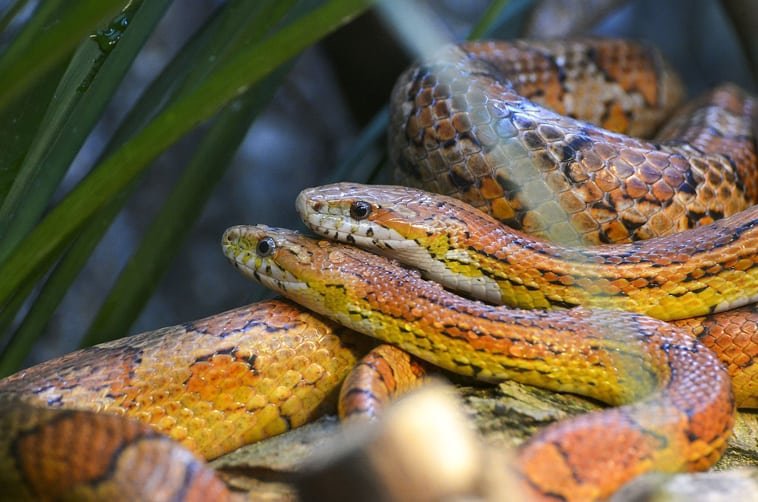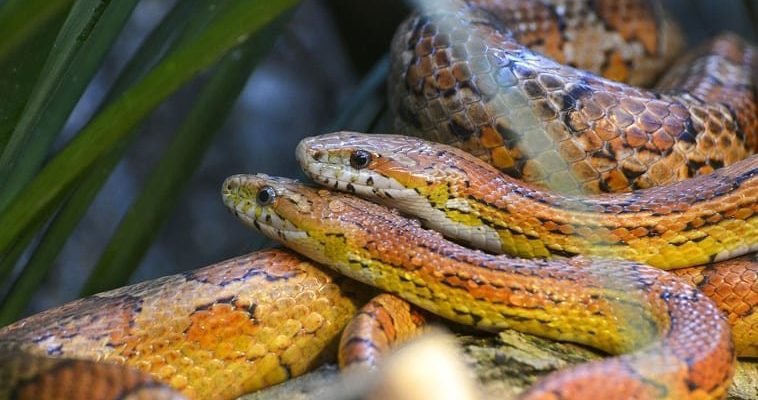
Corn snakes are typically friendly and adaptable creatures. However, before you dive into co-housing, there are some important rules and guidelines to consider. After all, you want to ensure that your snakes live harmoniously and that you’re providing the right environment for them. This article will walk you through everything you need to know about whether corn snakes can live together, how to set up their space, and what to monitor for a peaceful coexistence.
The Basics of Corn Snakes
Corn snakes are popular pets known for their gentle temperament and striking patterns. These snakes can grow to be about 3 to 5 feet long, with some individuals even reaching up to 6 feet. Because they’re relatively small and manageable, many enthusiasts enjoy keeping multiple snakes. But it’s essential to understand their social behavior first.
Corn snakes are solitary creatures by nature. In the wild, they don’t typically share their dens or basking spots. This means that while they can be friendly, they aren’t naturally inclined to live together like some other species might be. So, you might be wondering, “Why would I even consider co-housing?” Well, it often comes down to space and resources. Let me explain what to consider.
Space is Key
If you’re going to house multiple corn snakes together, you need enough space. This means having a large enclosure that allows each snake to have its own territory. Think about it like sharing an apartment: everyone needs their room to feel comfortable!
A good rule of thumb is to provide at least a 40-gallon tank for two corn snakes, but larger is always better. Each snake should have access to hides, climbing branches, and separate basking areas, so they can retreat when needed. Without this separation, you could see stress or even aggression between your snakes.
Compatibility and Size Considerations
You might be wondering if all corn snakes are suitable roommates. The answer is: it depends. Age, size, and temperament can all affect how well they get along. For example, pairing a younger snake with an older one is generally not recommended. The younger snake might simply become a target.
When considering size, you want to avoid housing snakes that are significantly different in size. A smaller snake could be bullied or, in extreme cases, eaten by a much larger one. Ideally, you should house corn snakes that are of similar size and weight, as this helps balance dynamics and reduces stress.
Remember Their Temperament
Temperament also plays a crucial role in compatibility. Some corn snakes are more laid-back while others can be quite feisty. If you observe any signs of aggression—like hissing or striking—separating them is the best course of action. You want to create a peaceful home, not a battleground.
Setting Up the Perfect Enclosure
Creating a harmonious living environment for your corn snakes is vital. The enclosure should mimic their natural habitat as closely as possible, featuring plenty of hiding spots and climbing opportunities. Here’s a breakdown:
- Hiding Spots: Use various hides like caves or boxes. This gives your snakes a place to retreat and feel secure.
- Climbing Areas: Corn snakes love to climb, so using branches or shelves can be beneficial.
- Temperature Gradients: Provide both a warm and cool side in the enclosure, allowing each snake to regulate its body temperature.
Substrate Matters
The substrate you choose can also impact their health and well-being. Opt for materials like aspen shavings or cypress mulch that allow for burrowing but also enable easy cleanup. Avoid sand or gravel, as these can pose health risks to your snakes.
Feeding and Care Considerations
One of the biggest challenges of co-housing corn snakes is feeding time. If you feed them in the same enclosure, it can lead to competition and aggression. It’s best to feed them separately to ensure each snake gets its share without any conflicts.
When feeding, keep an eye on each snake’s eating habits, as a sudden change can indicate stress or illness. Make sure you’re also aware of how often each snake eats; younger snakes typically need to eat more frequently than adults.
Hydration is Essential
Don’t forget to provide fresh water at all times! Having two water dishes is an excellent way to ensure that both snakes stay hydrated. Just like we need a drink after a long day, your snakes also need easy access to clean water.
Signs of Stress and Aggression
Monitoring your corn snakes is crucial if they’re sharing a space. Signs of stress or aggression can manifest in several ways, including:
- Hiding Constantly: If one snake is always hiding, it could be feeling threatened.
- Hissing or Striking: These behaviors indicate that one snake may not be comfortable in the presence of the other.
- Loss of Appetite: If a snake stops eating, it could be a sign of stress.
Keep an Eye Out
If you notice these signs, be ready to intervene. You may need to separate the snakes to ensure their well-being. Remember, the goal is to create a safe and happy living environment for both snakes.
Alternatives to Co-Housing
If co-housing seems too risky or complicated, don’t worry—you have alternatives! Many snake owners prefer to house each snake in its own enclosure. This way, each snake has its own space, reducing stress and potential conflict.
You can always rotate their time out for exercise or handling. Just be sure to monitor them closely when they’re out of their tanks. By doing this, you can still enjoy the company of multiple corn snakes without the hassle of co-housing.
Consider Your Lifestyle
Think about your lifestyle and how much time you can dedicate to observing and caring for multiple snakes. Sometimes, a solo setup is the best way to go for both you and your snakes.
So, can corn snakes live together? The answer isn’t a simple yes or no—it ultimately depends on several factors. With the right setup, similar sizes, and proper monitoring, co-housing is possible. However, if you’re ever in doubt, separating them is usually the safest option.
Taking time to get to know your snakes’ personalities, needs, and behaviors will help you make the best decision. Remember, the well-being of your snakes should always come first. Whether you choose to house them together or keep them apart, what matters most is creating an environment where each snake can thrive. Happy snake-keeping!

